Exploring the Hejaz Mountains
The Hejaz
mountains form a spine running down the western side of Saudi Arabia. In the
past I have had the good fortune of being able to visit the south west of the
Kingdom and have seen the cities of Abha, Taif, Makkah (Mecca) and Madinah
(Medina), all of which are in or near the mountains. Last year Elaine and I
managed to visit Al Ula, which is one of KSA’s UNESCO world heritage sites, and we had been amazed by the beauty of the geology of the area. So, stuck in Saudi
without my wife and a weeks’ holidays for the Eid-al Fitr approaching, this was
an opportunity to revisit Al Ula and explore more of the area. A curling friend
in Riyadh introduced one of his friends (whom I shall call Mr J) who was also
wanting to travel, and so we teamed up.
We made up a wish-list of things we wanted to see, and these included the city of Medina, the railway wrecks on the Hejaz Railway, Al Ula area and the WH site at Hegra, the Red Sea in the Neom area, and Jebel Al Lawz. I arranged the flights and car hire, and Mr J. booked accommodation options that we had both agreed was either acceptable or expedient.
So, on Saturday 8th May we met at Riyadh airport and flew to Madinah. I had tried to book a 4x4 capability vehicle for the visit, but none of the booking sites offered one that we could pick up in Madinah and drop off at Tabuk. However a discussion with the booking agent on site at MED airport solved the issue and for a modest increase in price I was able to drive off in a Toyota Rav4. We dropped our bags at the airport’s Millenium hotel and set off to explore the city. Tripadvisor lists the top 10 things to do in Madinah as the Prophet’s Mosque (where the prophet Mohammed [peace be upon him] is buried) in the number 1 position. As non-Muslims we could not visit this magnificent-looking mosque as it is haram. 7 more top-10 attractions were mosques, leaving us the old station and railway museum, and the Mount Uhud battle site. A drive to the former found it to be closed, despite the sign declaring the visiting hours being open at that hour. A drive around the site elicited no alternative way of entry. So off to Uhud which is a hill on the western fringe of the city, and the site of a 7th century (Gregorian) battle between the armies of Madinah and Makkah. No brown tourist signs, or exposition boards giving the history of the area, for what was not a particularly decisive battle with historic implications, with Mohammed’s (PBUH) small Muslim army seeing off the larger number of Meccan raiders. The two armies would meet again, with the Muslims eventually becoming victorious. There was a track up the hill, and the 4x4 proved its worth with a couple of tricky bits that would have beaten a saloon car. There was a grand view from the top, making it well worth the drive. Being the last few days of the holy month of Ramadan, I knew that restaurants would not open until after sundown, and so we headed for a hardware outlet to buy a cool-box for the car, and then to a mall for something to eat after the Mahgrib prayer call.

Madinah from Uhud
Somewhat to
my surprise the hotel advised it would serve a daytime breakfast for non-muslims
in its restaurant (I was expecting to have to order via room service), so the
next morning Mr J and I had a well-fed and leisurely start to the Sunday. The
kitchen even provided ice for our cool-box, and we set off, picking up some
travel-essential foods at a garage on the outskirt of Madinah.
Heading north, we soon picked up the trackbed of the abandoned Hejaz railway, which had been built by the Ottomans and opened in 1908 to transport pilgrims from Damascus to Madinah (and on to Makkah, however for political reasons this extension was not constructed). It took until 2018 for a railway to open between Madinah and Makkah – the Haramain high speed line. The 700+km Hejaz line in KSA was abandoned after the first world war and the end of the Ottoman Empire, not so much as due to the attacks by Arabs and Lawrence of Arabia, but there was no political will to rebuild it from the tribal Arabs who would not be united until 1932 under King Saud. And so it lies gently decaying where operations stopped and facilities were abandoned. The Ministry of Culture has erected fences around the stations and train remains to stop pilfering, but not any historical information. For more information on the railway specific aspects of the Hejaz, please refer to the next blog item to be published.
After some exploration and a little off-roading, we rolled into the city of Al Ula in the late afternoon, and found the hotel, but there was no sign of life. Eventually after some phoning and Whatsapp-ing with someone who spoke no English, and we had sent a photo of the exterior of the hotel to prove we were there, the concierge appeared, evidently roused from slumber, to let us in. The rooms were clean and comfortable, but basic, and there was no food available at all. My room wasn’t too bad, but Mr J’s had some seriously dodgy wiring in the bathroom. With an hour or so before sunset, we drove up the mountain overlooking Al Ula city and enjoyed the panoramic views. Back in the city at dusk, we looked for a restaurant that was open, but not a single one was. It looks as if they served takeaways for locals for their iftars and then closed. We had a stroll in the old city quarter, which had been closed during our visit last year, and the main street has been revamped with new restaurants (closed) and gift shops (closed) installed in the old buildings. So with no sit-down options for food, we bought bread, cheese, fruit and other convenience nourishment and ate in the hotel bedroom. Breakfast for the next 2 days was a repeat of that, too.
Monday saw us explore the city (we had no option, the hotel was at the far south end of the town, and the interesting bits were at the north, and there was only 1 main road through it), before we headed for Elephant Rock. The short drive into the desert here is now aided by a brown tourist sign at the road end, and the track now leads to an organised car park, conveniently placed 100m to the north of the rock. The southern approach now comprises of an open-air café/lounge. A couple of “security guards” drove up (unmarked car with seats in full recline/sleep position, the guards possibly old enough to start shaving, but that’s uncertain), and tried to tell us in sign language to come back after 8.00pm. We told them we only wanted photos, and didn’t need coffee or shisha, so thanked them for their help and let them retreat to continue their rest. Joni Mitchell was indeed right.
“They paved
paradise and put up a parking lot
With a pink hotel, a boutique, and a swingin' hot spot
Don't it always seem to go
That you don't know what you got 'til it's gone
They paved paradise and put up a parking lot”.

Elephant Rock, 2021. Compare to blog entry of August 2020.
Next, we set off to explore the area further, and have a really close look at the rock formations of the area. Mr J has a degree in Geography and we spent some time devising theories for the wonderful scenery, with volcanic eruption, wind and water erosion the more rational of these. The 4x4 was a big help in allowing us to access the rockfields.
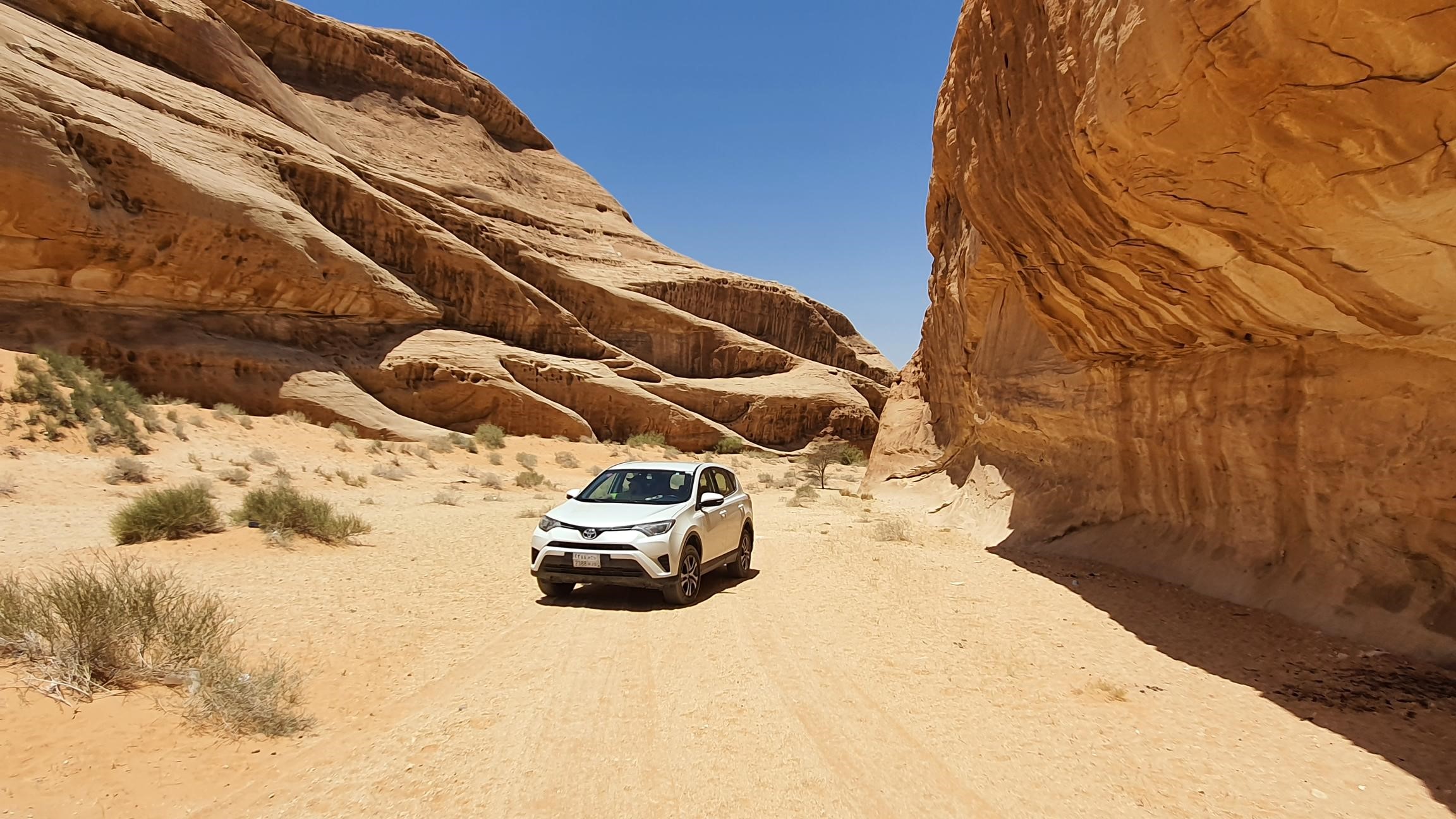
Exploring the rockfields
We had booked tickets for the official tour of Madain Saleh / Hegra, and for this we had to meet at 2.30pm at latest at a meeting point at the north end of Al Ula city. We arrived at the rendezvous point in good time and boarded the tour bus. It, however did not set off until 3.00pm, despite dire warnings printed on the tickets it waited for stragglers to shuffle up late. This, as a transport professional, is one of the things that really annoys me about KSA, that they have to make allowances for the lazy members of society. However, the visit to the Hegra site was worth every one of the 95 SAR entrance money, with the bus dropping us of at the Madain Saleh railway station where one of the workshops had been converted to a reception handing out water, dried fruit and dates (in Ramadan!) and an exposition of the Nabatean site. Thus refreshed, we reboarded the bus and set off around the ancient rock tombs, stopping at 3 locations for 30 minutes at each. Our hitherto dumb guide burst into life and gave a commentary on each place, and knowledgeably answered questions in English. Our exit from the park was via the gift shop, located in the adjacent building at the station to the reception/exposition centre. As is standard for customer service personnel in KSA this was operated by Filipinos who spoke good English. Mr J was disappointed that they didn’t offer fridge magnets of Elephant Rock. And finally back on the bus to Al Ula, after a very enjoyable visit.
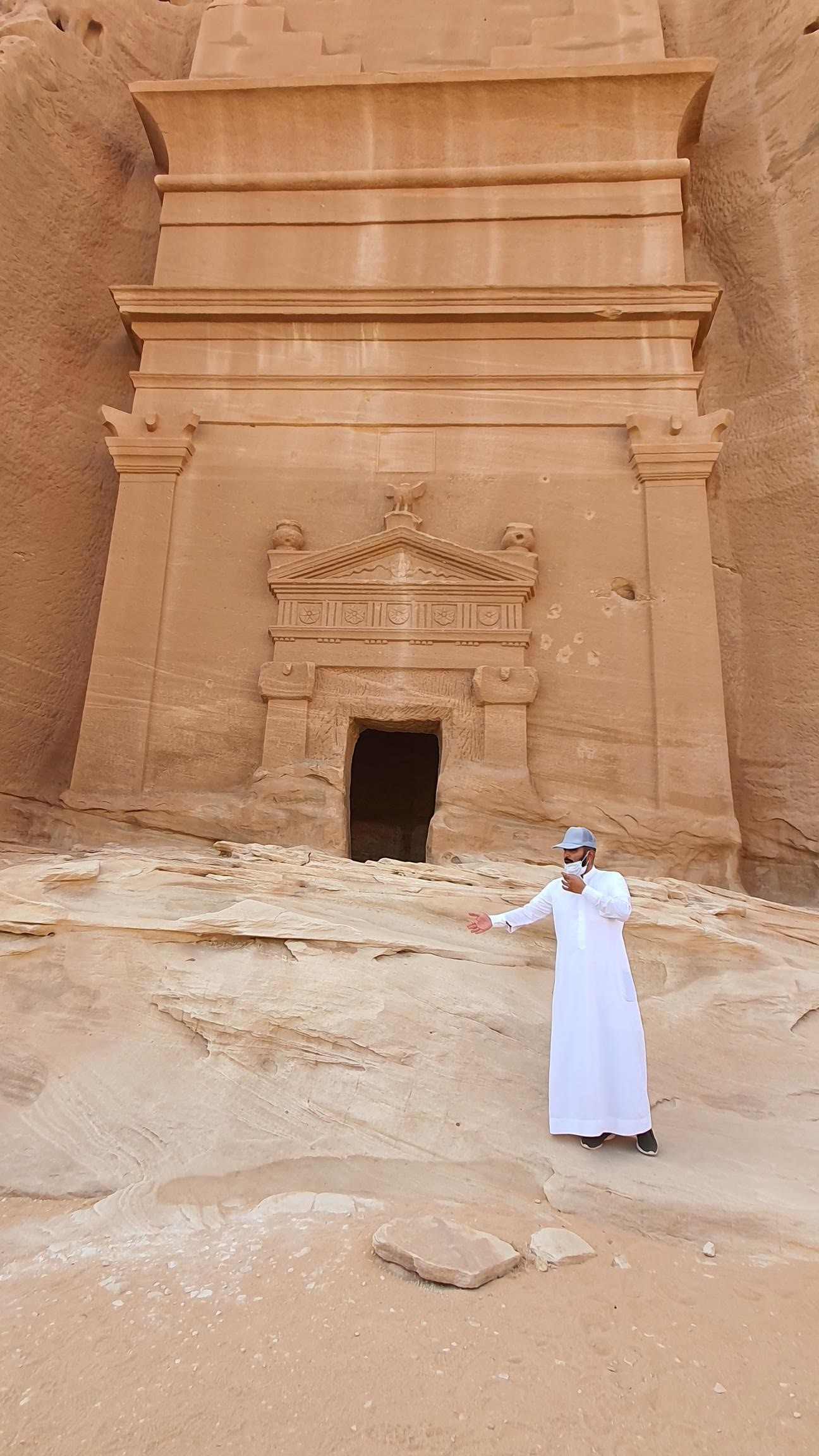
Our tour guide warming up.
It was approaching dusk as we returned to town, and after our unsuccessful efforts the previous day to find anywhere that would sell us food, we single-mindedly set out to remedy that situation. This was pretty fruitless, even a pizza parlour which was still clearly serving people claimed to be closed to us – and arguments were to no avail. Finally just as Mahgrib was being called we were invited in an Indian restaurant to join the Kerelan community within at their iftar, which was delicious spread of dates, breads, samosas, aloos and other such foods. This was washed down with fresh mango juice. One of the participants spoke a little English, and this made for a better discussion. At the end of the meal we tried to pay, however this was refused, and even offers of a donation to charity or their childrens’ education was waved away. Truly a refreshing and humbling kindness.
On Tuesday, after a room-based breakfast we hit the road again. First was a trip to find a Hejaz remain we had missed on Sunday, then the scenic road to Tabuk. Initially this was west on route 8776, then north on 8451 / 8900. This was a lively drive with some sections offering beautiful vistas to the horizon, and other sections with hairpin bends.
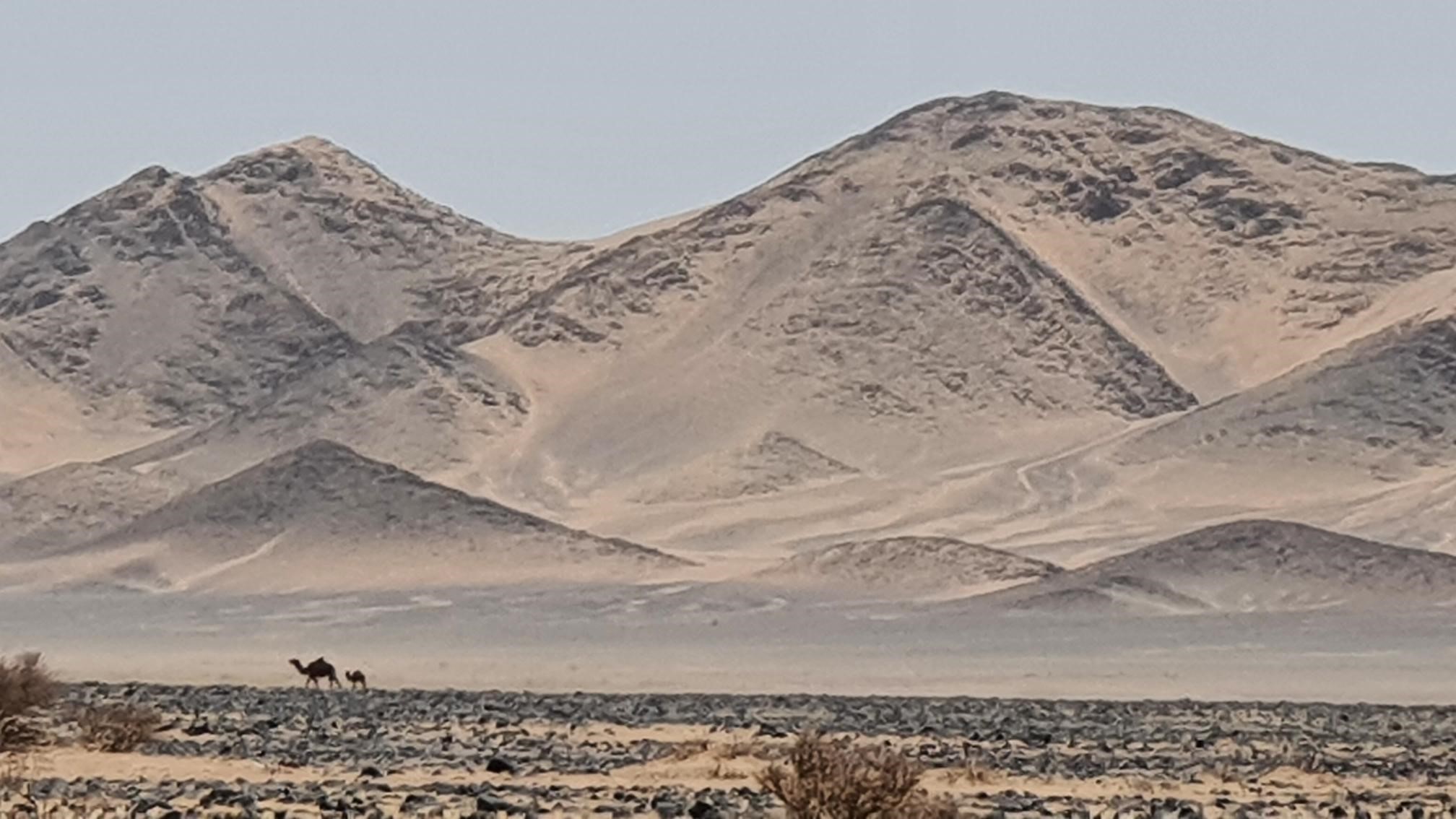
Hejaz scenery
One section was so steep that it was prohibited to lorries, and just to illustrate the point, halfway down it there was a lorry parked on its roof and its cargo scattered about.
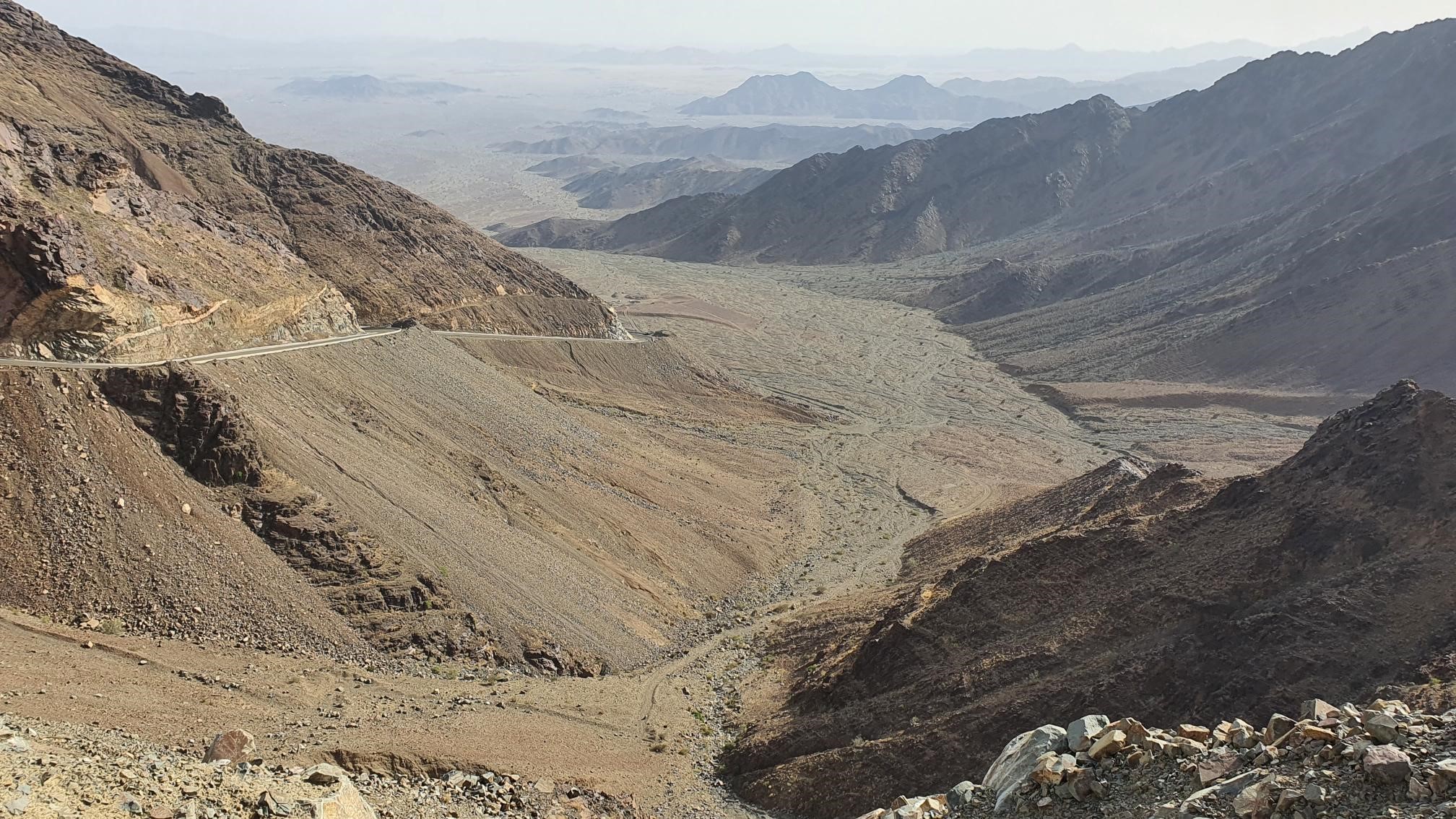
On the road to Tabuk
It was again approaching dusk as we drove into Tabuk. Fortunately we had met an English couple in Al Ula who lived in Tabuk, and they had recommended an Indian restaurant called the Biriyani House, and this served us a sit-down meal at iftar time. Here it was a proper commercial meal, and the waiters could be seen having their staff iftar in an adjacent room, popping out occasionally to serve the total of 6 diners who had come in. We then found the hotel which was one of those apart-hotels that you get in KSA. Basically an apartment block with the rooms marketed on the internet. Mr J had booked this one through Booking.com, and without going into details, it was appalling. He is following up with the booking agency and hopefully they will be de-listed. On the funny side, the concierge was so inept that he couldn’t operate the credit card reader properly and did not put in the .00 after the 343 SAR payment, which gave us a 99% discount of 3.43 SAR – about 70p or $1.00 for 2 nights. We did not notice this until the next day when the hotel started calling Mr J to return and complete the payment. As they spoke only Arabic and we didn’t, all we could say was that we were out for the day and we would settle up in the evening. There were no towels in the hotel so we went to a nearby supermarket to buy a couple, and the Yemeni attendant there commented that this was a frequent sale for him.
Next morning we varied the self-made breakfast by eating cornflakes out of paper cups, which worked but not as efficiently as bowls would have done. Ramadan was now finished and Eid had been declared so during the day we did not have to eat in a clandestine manner, and we looked forward to a meal of our own choosing in the evening. Today was a trip to the seaside, so we drove west from Tabuk to Duba, a modest town on the Red Sea. This town had an incomplete playpark on its corniche with models of world famous towers, those included the Eiffel Tower, Big Ben, the Leaning Tower of Pisa and the Kingdom Tower (Riyadh). Despite this town’s name being 80% of Dubai there was no similarity whatsoever between the two - apart from a tiny Burj Khalifa in the park.
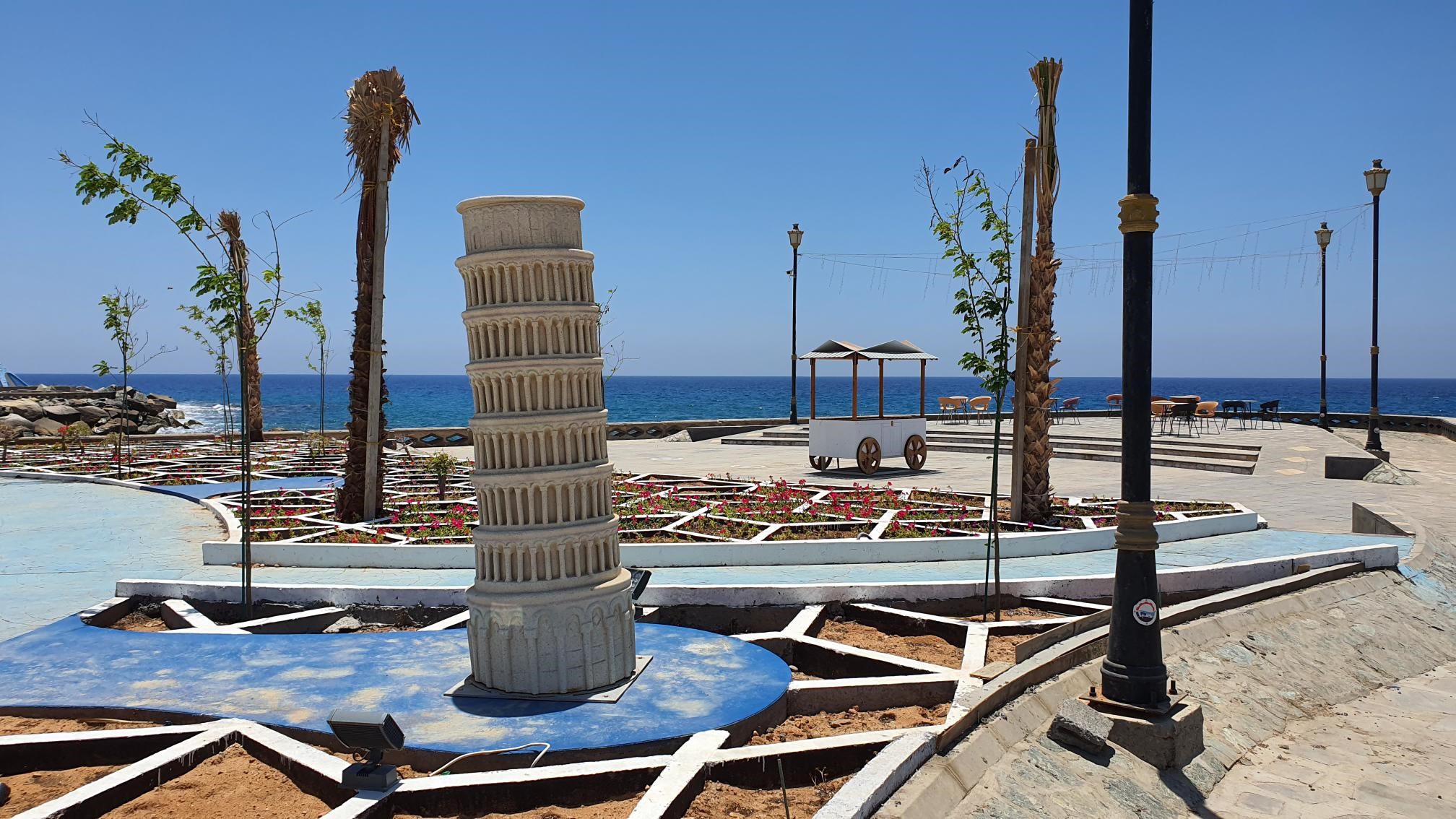
Park in Duba
Having decided the seaside town had nothing more for day-trippers we drove north up the coast road. We stopped at Al Muwaileh – a coastal village with nothing to commend it apart from being coastal – and parked on the deserted beach and had lunch and a paddle in the sea. By now we had entered the area of Neom – the wonder project that when finished will make Dubai look like Duba. I will not try to explain the Neom project, please look it up yourself to see the staggering investments involved. What appeared to be completed was a gated community of palaces around a golf course on a headland. A few kms inland from that was the Neom construction campsite, which from observation appeared to be a large trailer park. The car park was impressive itself for the number, size and quality of the cars there, and the nearby heliport. Curiosity satisfied, we travelled on north and west coming finally to the end of the road at Ras Alsheikh Hamid. Here was a coastguard station/border guard post and views over the mouth of the Gulf of Aqaba to Sharm El Sheikh in Egypt. More beach time.
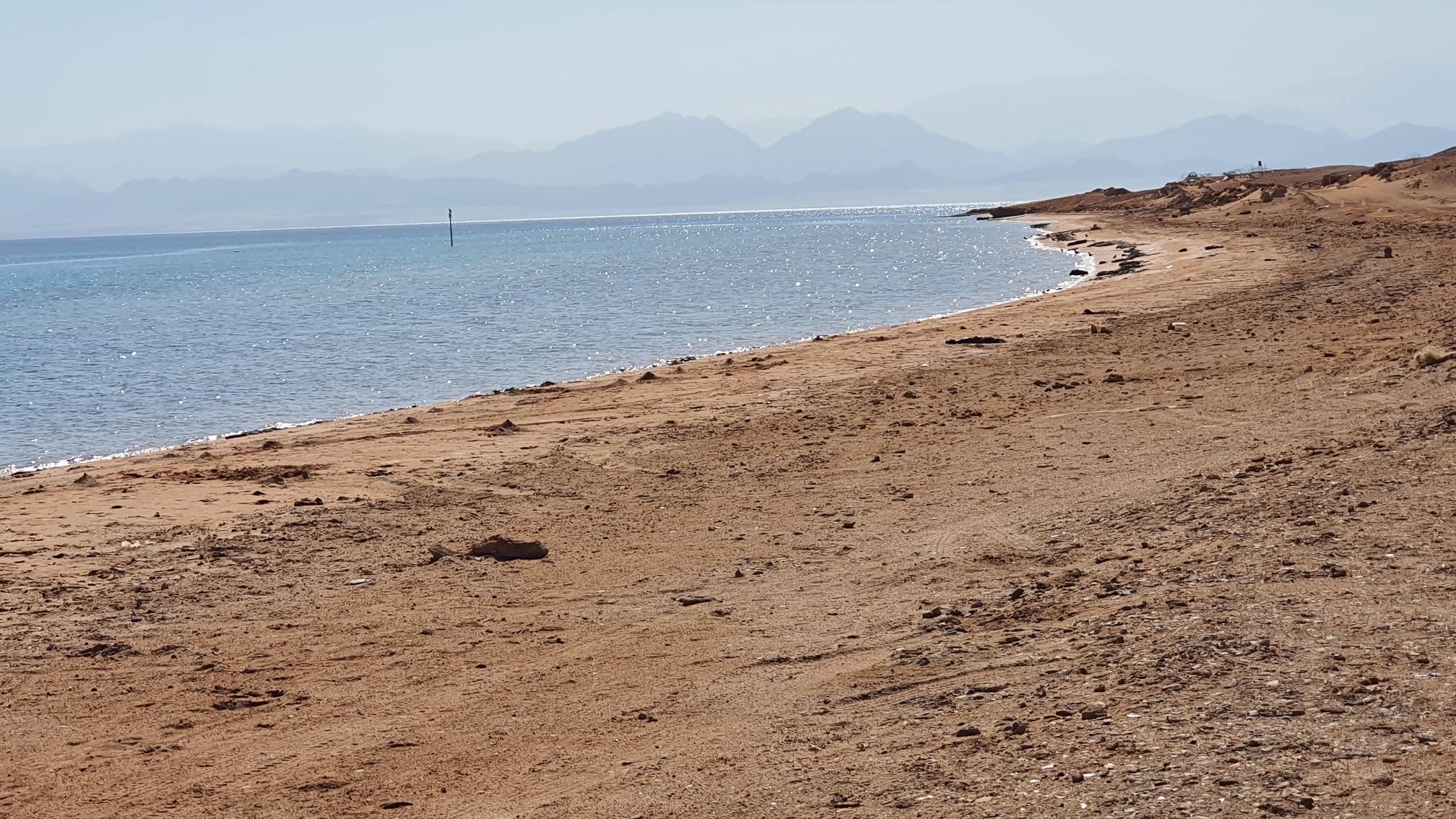
Egypt in the distance
Nearby was the wreck of a Catalina seaplane that was shot at anchor and captured by Saudi Bedouins in 1960. The American family who were undertaking a round-the-world flight escaped serious injury, but that’s where their journey ended. For a description of the event please see http://www.aviationsurf.me/2020/11/the-abandoned-consolidated-pby-catalina.html and http://www.artificialowl.net/2009/07/abandoned-catalina-seaplane-50-years.html Fascinating.
The drive back to Tabuk was again scenic and fuel was taken at Sharma from a pop-up petrol station, where everything appeared to have been supplied in 40’ shipping containers and set up in a few hours. Clever. In Tabuk, with the Ramadan restrictions now over there was a big choice of restaurants so we dined in a middle-eastern joint whose name translated to “Touches of the Past”. The staff were super-friendly and we were provided with the best meal of the trip. We were invited to sit at a pavement table and have coffee and sweets with them after the meal. They had a menu displayed which had been translated from Arabic to English by someone using a dictionary – or Google Translate – without any idea what the output was. This offered enticing dishes such as “Meat cheats”, “Meat impregnation with milk”, “Beef pressed person with rice”, “Mini sofa”, “Groats”, and “Custard solution (coated)”. This place goes straight into my all-time top 3 menu translations, beaten only by “Lobster marinated with herpes” (Taif KSA 2016) and “Chicken beaten up in the manner of the local people” (Rzeszow, Poland 1986).
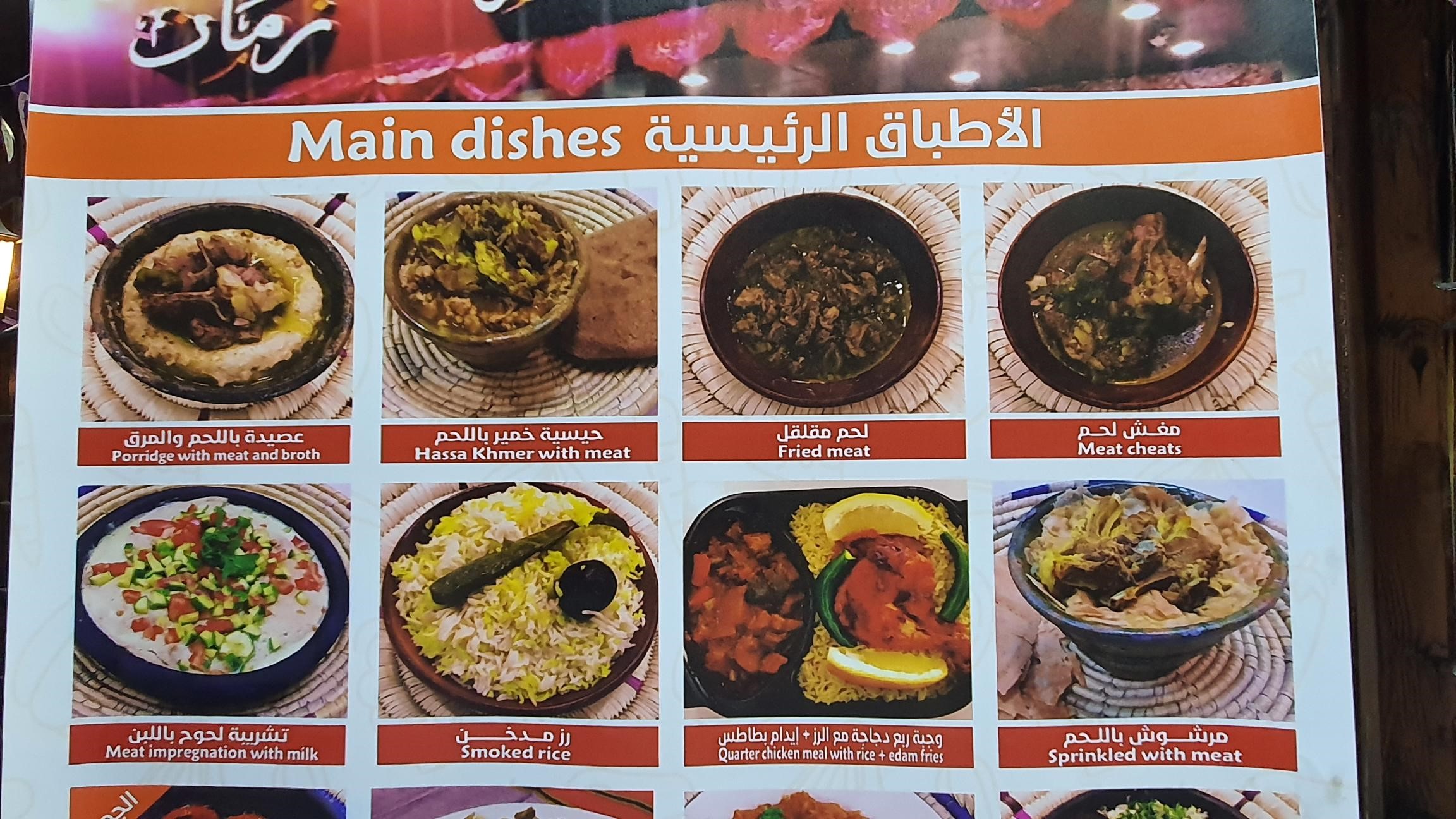
Fortunately there were pictures to give us a clue to the contents
On our final day, after checking out from the apartment (top tip – avoid anything with the name OYO – presumably an acronym for On Your Own regarding facilities and cleanliness) we were off to see Tabuk Castle. This was a 16th century build to protect water supplies on the pilgrimage routes, but although a listed tourist attraction it was closed, either for Eid or for Covid. So out of town again, this time north and west to the Jebel al Lawz area. According to some historians, this mountain was where Moses paused on his flight from Egypt to receive the Ten Commandments. Others point to Mount Sinai in Egypt, so there is doubt. But whatever, this is a beautiful and desolate area and although the final stage of the mountain road is closed to protect a military installation, other tracks can be explored by 4x4s and with no tourism interpretation, the area is what you make of it. We left the car at a safe spot and did a little exploration on foot to experience the area further. It was so cool and peaceful.
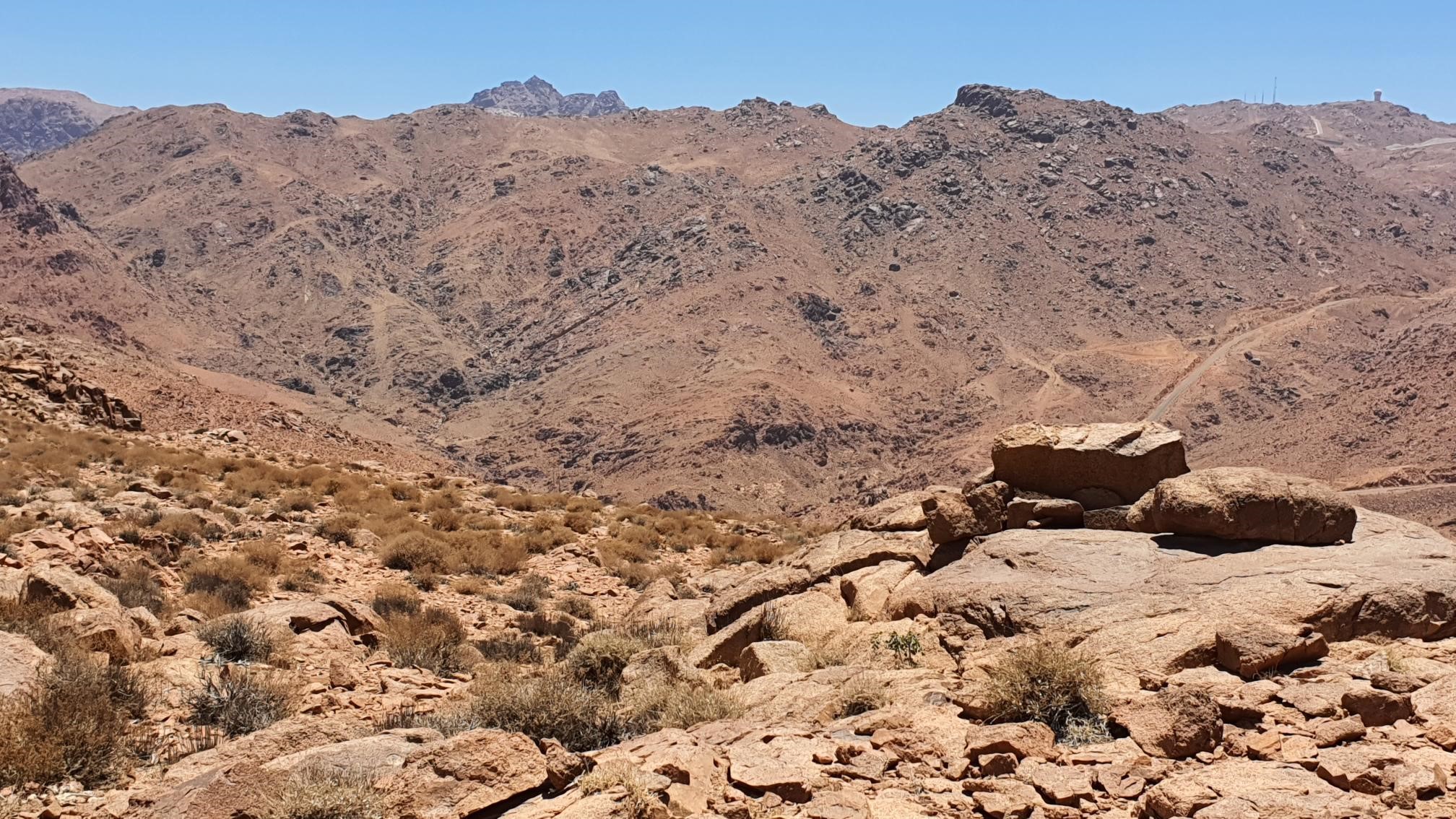
Jebel al Lawz area
Back down to the main road we continued west to the coastal town of Haql. This is well up towards the north end of the Gulf of Aqaba, not far short with the border of Jordan and the points where Israel and Egypt meet too. The town had a series of beach-front apartments for hire, and lo-and-behold! – a public swimming beach. No facilities for changing, showering or having a coffee, but after 2 nights of avoiding the suspicious looking shower in the hotel I was grateful for a swim. There were a couple of car-loads of Saudi youth who were amazed by the whiteness of a northern European and encouraged me in. The water was lovely, clean and warm. Later, dried and re-clothed I had an ice cream from a petrol station. And the drive back to Tabuk was spectacular through the Hejaz mountains. A fine day out by Saudi standards.
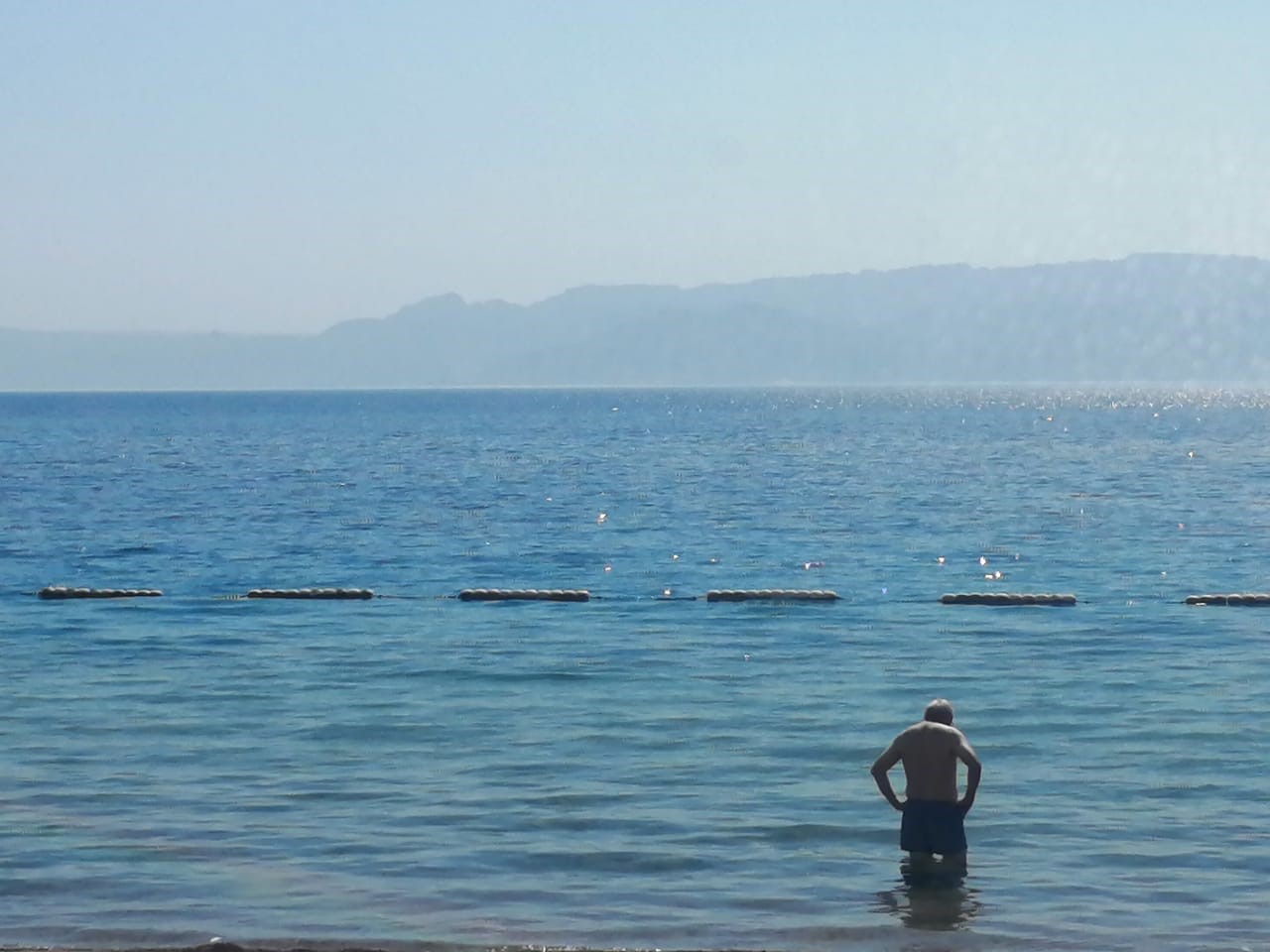
And so, a late evening flight from the modern but compact Tabuk airport back to Riyadh and the end of an mostly enjoyable 6 days in north-west KSA.
